Institut Charles Sadron Membre

Aurélie Hourlier-Fargette
- Téléphone : 03.88.41.40.00
- Send message
- CR
- Equipe : MIM
At the interface between physics and mechanics, my research interests are focused on elasticity and capillarity. In 2019, I joined the MIM team of ICS, and am developing research activities on foams.
You will find below the following information, in one single webpage:
- I - Research Interests
- II - Short CV
- III - Publications
I - RESEARCH INTERESTS : ELASTICITY, CAPILLARITY & INTERFACES, FROM SOFT MATTER TO MECHANICS
- Guided mechanical self-assembly of bubbles in fibre arrays (2022-...)
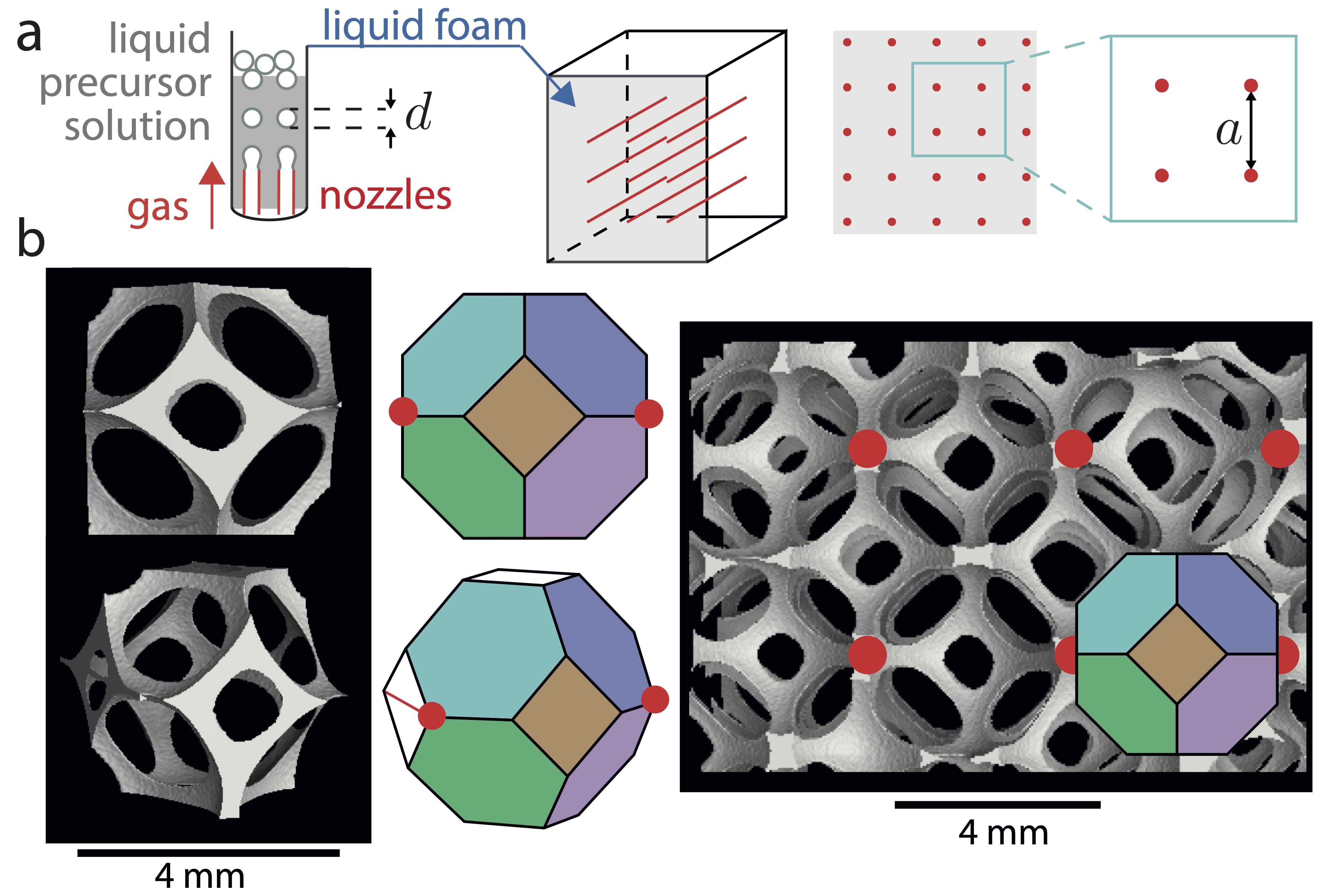
Spontaneous mechanical self-assembly of monodisperse bubbles often leads to disordered structures in dry foams. Producing crystalline structures requires specific care: Kelvin foams (assemblies of bubbles with six square faces and eight hexagonal faces arranged on a body-centered cubic lattice) are a typical example of structures challenging to obtain experimentally, even though they correspond to a minimum of energy. We have shown how bubbling in fiber arrays enables to control foam architectures through a guided mechanical self-assembly of bubbles, by considering alginate and polyurethane model foams that are initially liquid and are then solidified and characterised through X-ray tomography. The analysis of the 3D tomography images obtained is performed both visually and via the numerical extraction of the strut network and its analysis through Steinhardt's bond orientational order parameters. This work is available on the ArXiv here.
(with Marwan Chammouma, Manon Jouanlanne, Antoine Egelé, Damien Favier and Jean Farago)
- From liquid to solid foams: development of alginate model foams (2022-2024)
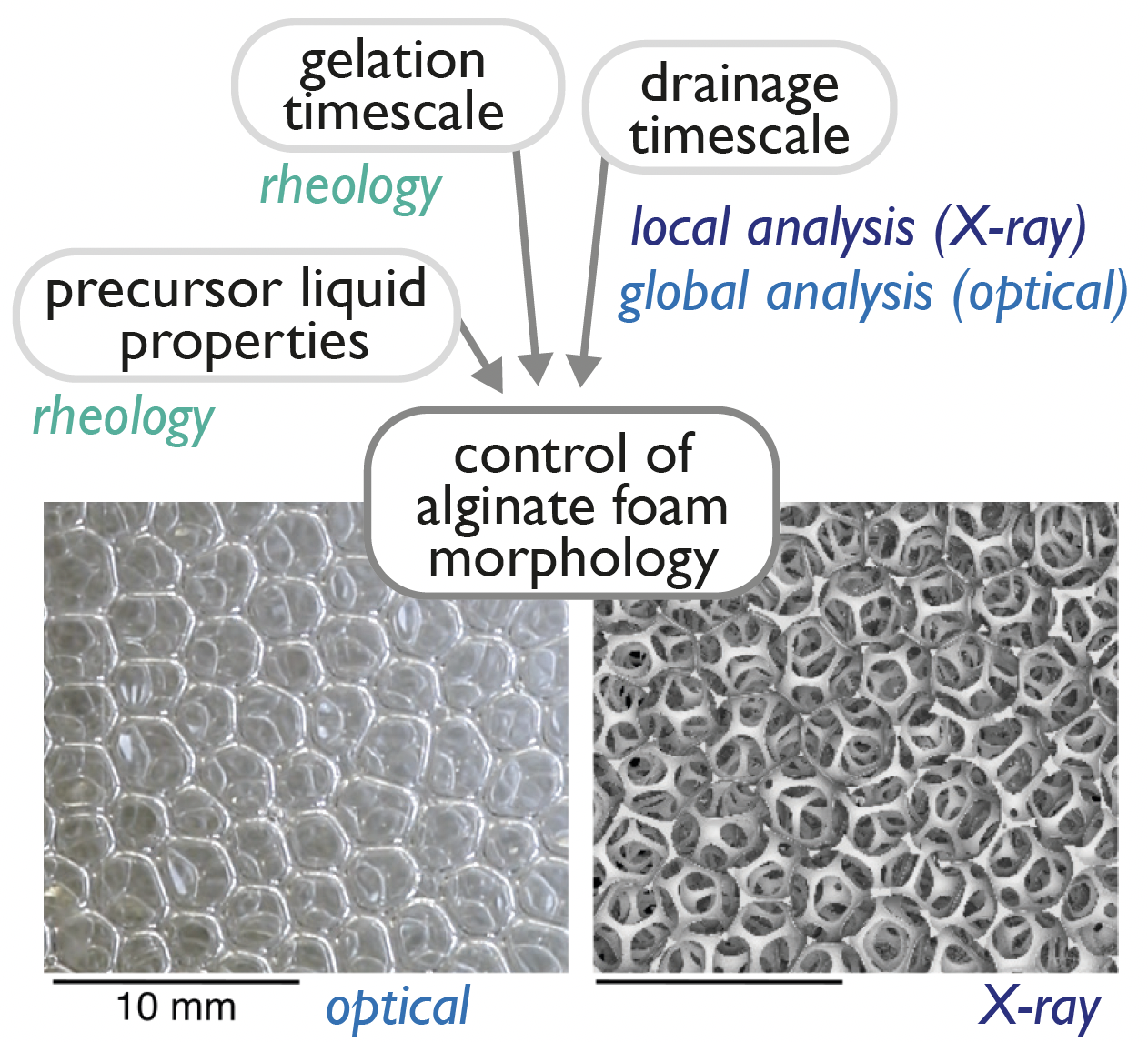
Hydrogel foams are widely used in many applications such as biomaterials, cosmetics, foods, or agriculture. However, controlling precisely foam morphology (bubble size or shape, connectivity, wall and strut thicknesses, homogeneity) is required to optimize their properties. Therefore, we developed a method for generating, controlling, and characterizing the morphology of hydrogel foams from liquid foam templates, using the example of Alginate-CaHPO4-based hydrogel foams. Bubbling nitrogen through nozzles into the solution produces hydrogel foams with millimeter-sized bubbles. Combining rheological characterisations and X-ray tomography, we show how the control of the temporal evolution of the foam via its formulation allows to tune the final morphology of the alginate foams. All results are presented in the article that we published in Advanced Materials Interfaces in 2024, chosen as Editor's choice by the journal.
(with Manon Jouanlanne (PhD student), Imene Ben Djemaa, Antoine Egelé, Leandro Jacomine, Wiebke Drenckhan and Jean Farago)
- From liquid to solid foams: development of polyurethane model foams (2021-2024)
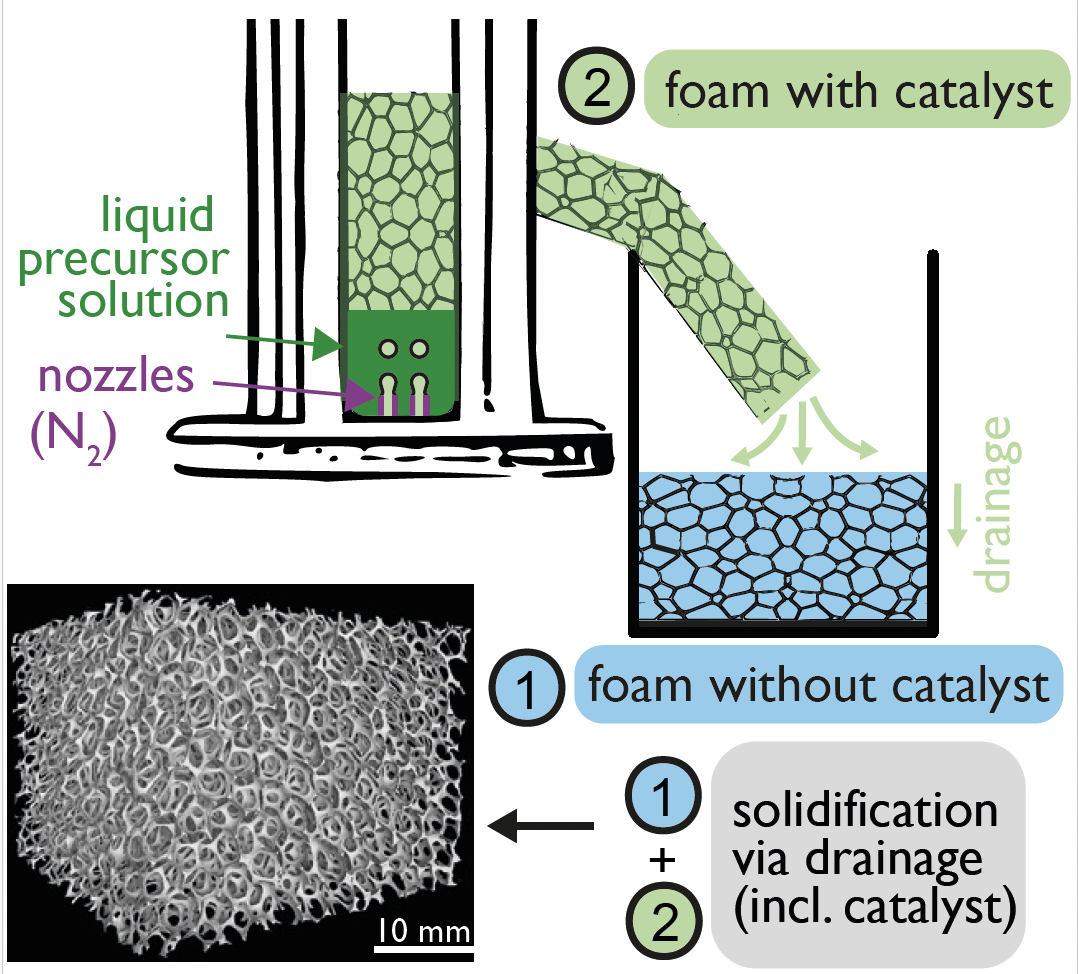
Due to their unique mechanical and thermal properties, polyurethane foams are widely used in multiple fields of applications, including cushioning, thermal insulation or biomedical engineering. However, the way polyurethane foams are usually manufactured - via chemical foaming - produces samples where blowing and gelling occur at the same time, resulting in a morphology control achieved by trial and error processes. We developed a novel strategy to build model homogeneous polyurethane foams of controlled density with millimetric bubbles from liquid templates. By producing a polyurethane foam via physical bubbling without a catalyst and gently depositing a secondary foam containing catalyst on the top of this first foam, it is possible to take advantage of drainage mechanisms to trigger the solidification of the bottom foam. The characterization of the samples performed by X-ray microtomography allows to study quantitatively the structure of the final solid foam, at the global and at the local scale. Using the tomographic 3D images of the foam architectures, the superimposed foam technique is shown to be promising to produce foams with a good homogeneity along the vertical direction, with a density controlled by varying the concentration of catalyst in the secondary foam. All those results are presented in the article that we published in 2024 in Macromolecular Rapid Communications.
(with Manon Jouanlanne (PhD student), Antoine Egelé, Wiebke Drenckhan and Jean Farago)
- Elastic ribbons in 2D foam columns (2020-2024)
Using elastocapillarity to control the architecture of mechanical assemblies have recently highlighted ways to fold, spool, or assemble elastic objects. However, those intelligent design approaches remain unexplored in the context of liquids with a hierarchical architecture, such as foams.
As a first step, we investigated the competition between elasticity and capillarity in a 2D foam column upon introduction of an elastomer ribbon. Confining soap bubbles into a square cross-section container leads to a quasi-2D structure of bubbles, with soap films connected at 120 degrees angles (as prescribed by Plateau's laws). We introduce elastic ribbons of different bending rigidities in the structure and quantify the equilibrium shapes of the foam/ribbon systems, both experimentally (X-ray tomography) and theoretically (energy minimisation under constraints). In addition, our proof-of-concept experiments show that such setup can be used as a method to mold materials with characteristic shapes and curves imprinted by the foam structure. More details can be found in the article we published in Soft Matter in 2022.
One of our pictures of this system has been selected for the final of the CNRS MECAPIXEL photography contest, which goal is to highlight the beauty of mechanical sciences.
The poster below has been awarded a Gallery of Soft Matter award at the March Meeting 2022!
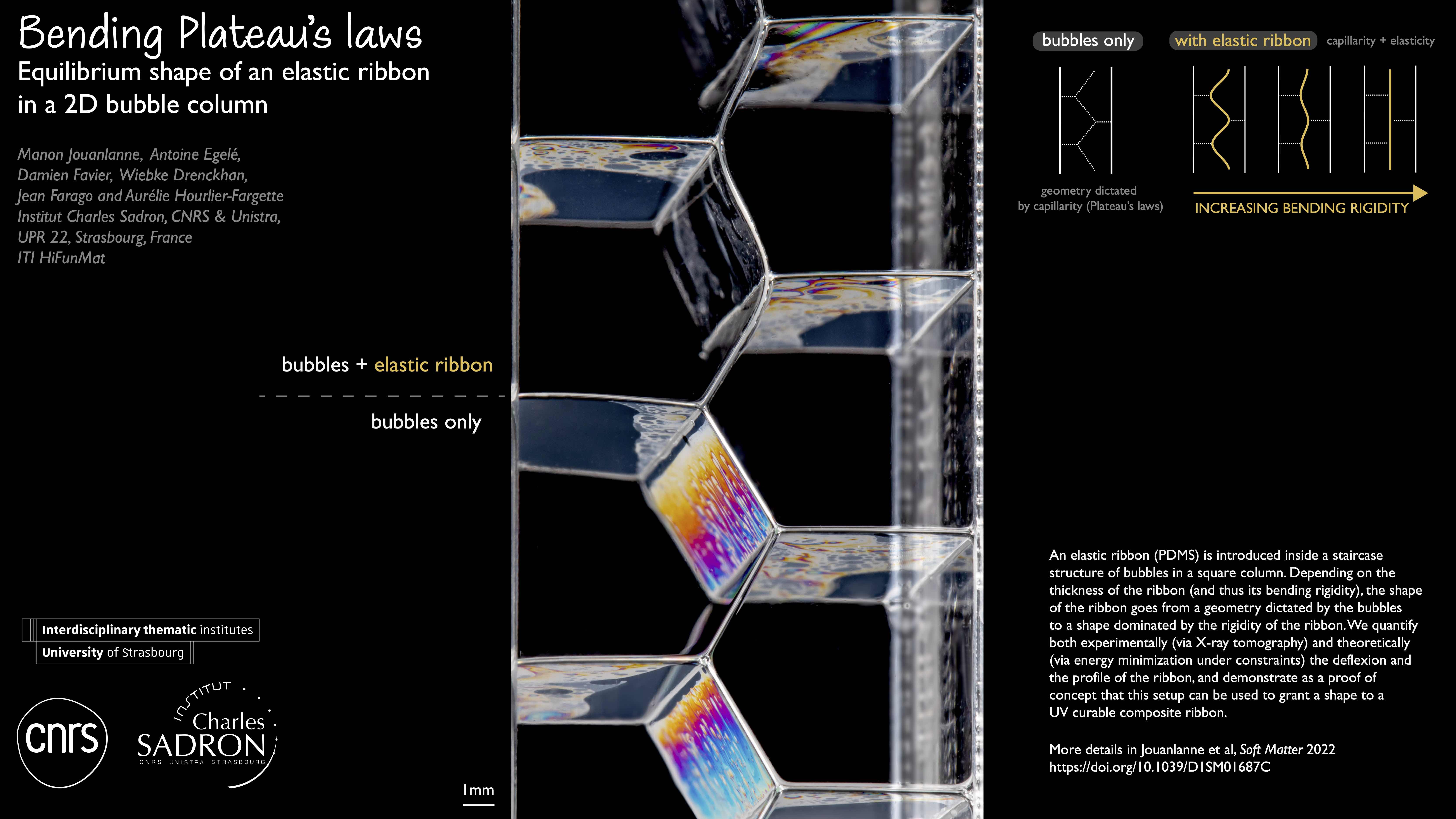
As a second step, we investigated the influence of gravity in such systems, in the article Elastic ribbons in bubble columns: When elasticity, capillarity, and gravity govern equilibrium configurations, that we published in 2024 in Physical Review E.
(with Manon Jouanlanne (PhD student), Antoine Egelé, Damien Favier, Wiebke Drenckhan and Jean Farago)
- Bubbling up in a lab on a chip towards polyelectrolyte multilayer capsules (2020-2024)
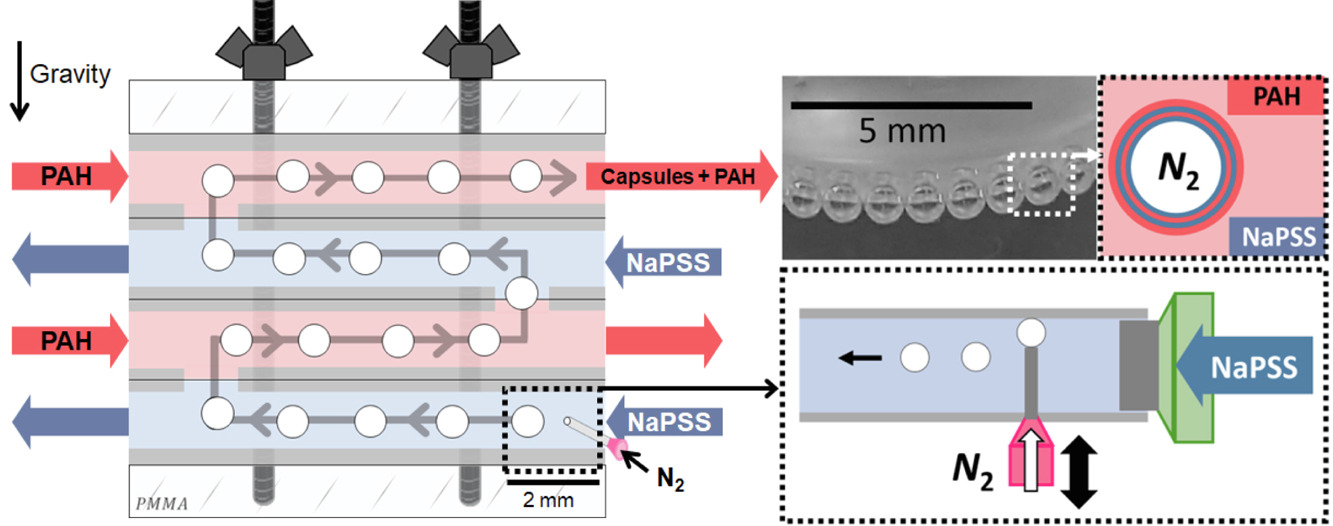
I had the pleasure to participate in a project led by Stéphane Pivard, Wiebke Drenckhan and François Schosseler on strategies to form polyelectrolyte multilayer capsules in microfluidic chips.
Nitrogen bubbles injected in superimposed microfluidic chips are travelling thanks to gravity ("bubbling up") through multiple solutions of oppositely charged polyelectrolytes to form Layer by Layer capsules with a polymeric skin. This work has been published in this article in Colloids and Surfaces A in 2024.
More details on this project can be found in the PhD thesis of Stéphane Pivard!
(with Stéphane Pivard, Guillaume Cotte-Carluer, Duzhi Chen, Antoine Egelé, Christophe Lambour, François Schosseler and Wiebke Drenckhan)
- Pore opening processes in foams and thin films (2020-2022)
Controlling the pore connectivity of polymer foams is key for most of their applications, but the underlying mechanisms are still poorly understood. In this project led by Sébastien Andrieux, the use of a microfluidic “Thin Film Pressure Balance” allow the investigation of isolated thin films under well-controlled environmental conditions reproducing those arising within a foam undergoing cross-linking and drying. Using the example of alginate hydrogel films, the evolution of isolated thin films undergoing gelation and drying is correlated with the evolution of the rheological properties of the same alginate solution in bulk. In the article we published in 2022 in Macromolecular Rapid Communications, the overall approach is introduced and a first set of results is presented to propose a starting point for the phenomenological description of the different types of pore-opening processes and the classification of the resulting pore-opening types.
(with Sébastien Andrieux, Mayur Patil, Léandro Jacomine, Sascha Heitkam and Wiebke Drenckhan)
- Stretchable electronics for vital signs monitoring (2017-2021)
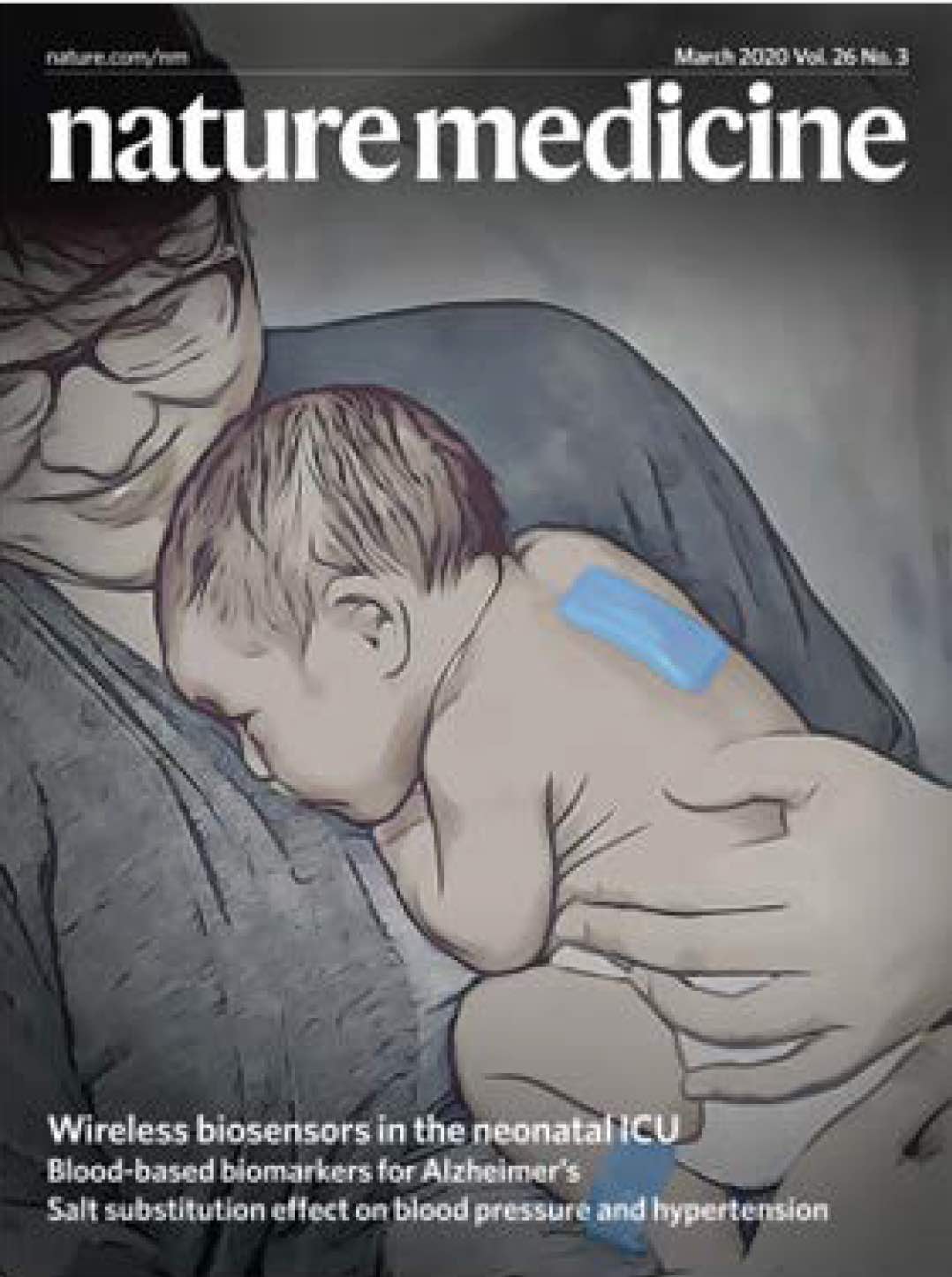
Monitoring of vital signs in a clinical setup is usually performed via a collection of hard-wired devices that adhere to the skin, and in certain instances, it involves catheter-based pressure sensors inserted into the arteries. In the most fragile populations, such as in neonatal and pediatric intensive care units, these systems can cause skin injuries and impede natural body movement and skin-to-skin contact with the parents. At Northwestern University and Chicago Lurie Children's hospital, we developed wireless skin-interfaced devices for non invasive physiological monitoring.
More specifically, I worked in John Rogers' group on the modelling of blood pressure and pulse wave velocity (article we published in PNAS in 2018) and on the development of a pair of sensors (one chest sensor and on limb sensor) that conformally adhere to the skin with soft adhesives to monitor health status. Our sensors capture heart rate, blood oxygenation, blood pressure via pulse arrival time techniques, respiratory rate, temperature, but also perform less conventional measurements via the embedded accelerometers, such as the determination of the child position and the capture of cry periods. More details can be found in the article we published in Nature medicine in 2020 (picture above). We also optimized the materials and mechanics, as well as the use of those sensors for blood pressure measurements in the context of neonatal and pediatric intensive care units: see the article we published in Advanced Healthcare Materials in 2021 for additional information.
(with John Rogers' research group)
- Skin-interfaced Microfluidics for in-situ analysis of sweat (2017-2021)
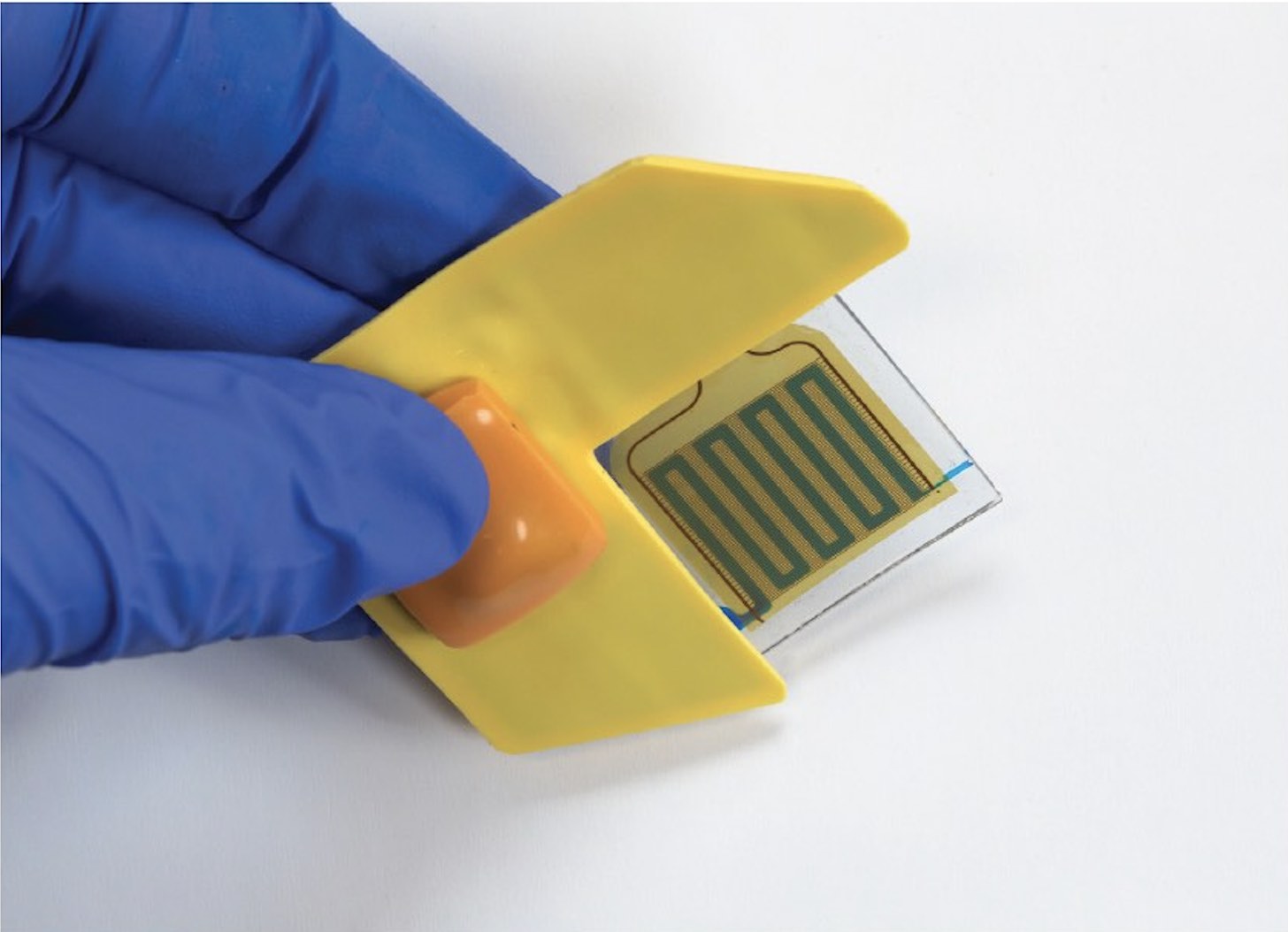
Important insights into human health can be obtained through the non-invasive collection and detailed analysis of sweat, a biofluid that contains a wide range of essential biomarkers. In John Rogers' research group, we developed a collection of skin-interfaced soft microfluidics platforms that offer capabilities for in situ capture, storage, and analysis of sweat loss and its constituents.
Our work focused on in-situ multifunctional colorimetric analysis of sweat (article we published in ACS Sensors), on resistivity measurements for real-time tracking of sweat loss and electrolyte composition (article we published in Small), on integrating enzymatic assays for measuring the concentration of ammonia and ethanol in sweat (article we published in Lab on a Chip), and on coupling colorimetric to digital assessments of a collection of parameters related to stress (article we published in PNAS). We demonstrated that soft skin-interfaced sweat stickers sensors can be used in a clinical setting for cystic fibrosis diagnosis and management (article we published in Science Translational Medicine).
The work I have led more specifically (article we published in Lab on a Chip in 2020) focuses on low-profile skin-interfaced systems that couple disposable microfluidic sampling devices with reusable ‘stick-on’ electrodes and wireless readout electronics that remain isolated from the sweat (featured on the picture above, that was highlighted on the cover of Lab on a Chip journal). Capacitive measurements with different geometries of electrodes allow contactless measurements through a ultrathin microfluidics capping layer, to determine sweat rate and loss and sweat conductivity, which contains information about electrolyte content. Electrodes couple to a flexible, wireless electronics platform that digitizes and transmits information to Bluetooth-enabled devices. On-body field testing during physical exercise validates the performance of the system in scenarios of practical relevance to human health and performance.
(with John Rogers' research group)
- Role of uncrosslinked chains in wetting on silicone elastomers (2014-2018)
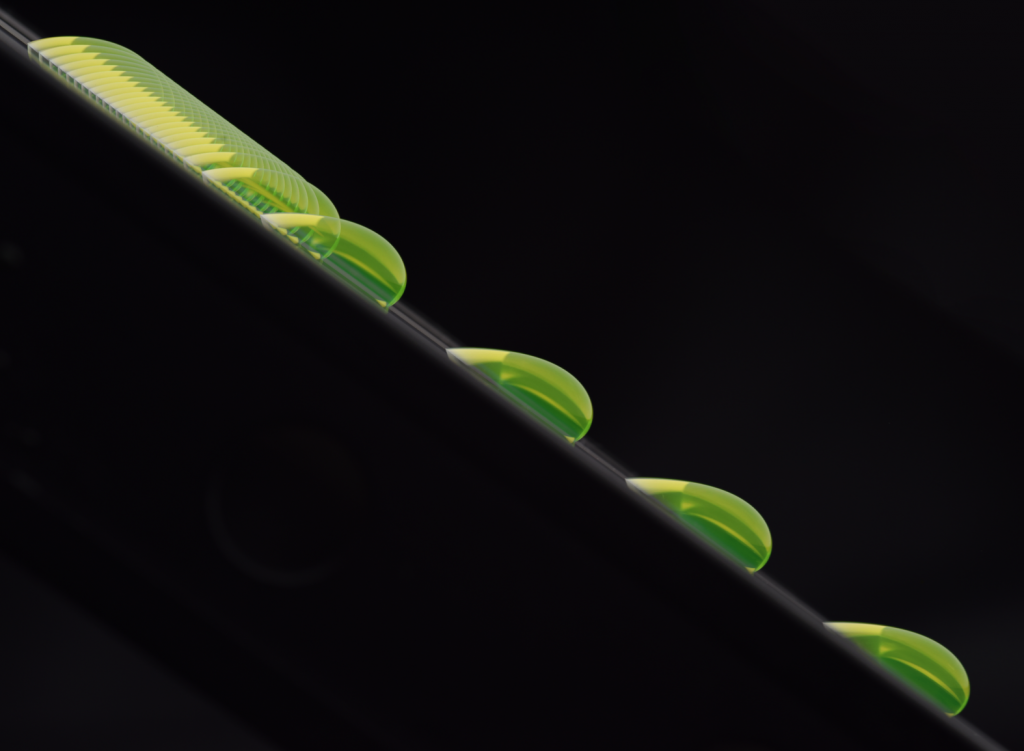
Beyond the importance of understanding the motion of droplets on stiff surfaces, the recent development of soft materials has lead to a growing interest for capillarity problems where soft interfaces and supports come into play. Silicone elastomers are easy-to-make substrates, used in various research fields such as microfluidics, or elastocapillarity, where experiments on slender bendable structures or thick soft substrates are performed. However, most commercial silicone elastomers are know to contain a small amount of uncrosslinked chains, the effects of which are not completely understood yet.
By focusing on the dynamics of water-glycerol mixture droplets sliding down plates of such silicone elastomers, I highlighted an unexpected behavior: we observed two successive regimes with two different constant speeds, and a sharp transition between them.
We showed that this behavior is due to the water droplet extracting uncrosslinked oligomers from the silicone elastomer through a capillarity-induced phase separation at the triple line.
We deduced from our experimental results and from results from the literature that the second speed regime is reached only when a complete layer of uncrosslinked chains is achieved on the droplet: this study reveals how minute amounts of contaminates have dramatic effects on the wetting dynamics. More details can be found in the article we published in Soft Matter in 2017. We also demonstrated that the contamination occurs at the triple line, and studied its dynamics. For those aspects, more details can be found in the article we published in Langmuir in 2018.
These findings could impact various research domains such as microfluidics or elastocapillarity as it contributes to a better knowledge of the interaction between water and silicone elastomers. Our droplet sliding experiment can also be seen as a simple test to evaluate the presence of unintended free oligomer chains by looking at the dynamics of water droplets on a test surface.
(with Arnaud Antkowiak, Sébastien Neukirch, Antoine Chateauminois and Julien Dervaux)
- Elastocapillarity with thin fibrous membranes (2015-2018)
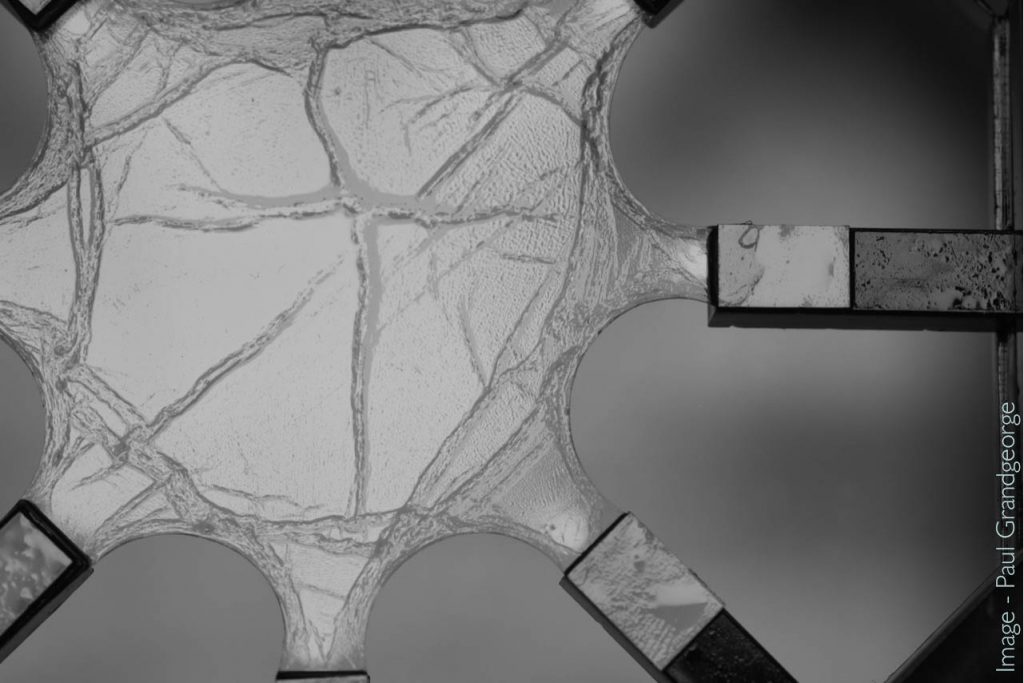
Elastocapillarity provides a novel strategy to develop highly stretchable materials, taking advantage of spontaneously formed surface reservoirs in wicked thin fibrous membranes. Competition between elasticity and capillarity results in bending of an electrospun nanofibrous liquid-infused membrane. That liquid-solid composite material is a cost-effective, resistant to fatigue highly stretchable mat, promising for applications ranging from conformable chemical surface treatments and stretchable basic electronic circuits.
More details on this project can be found on Paul Grandgeorge's website who was leading this project, and in his PhD thesis!
(with Paul Grandgeorge, Natacha Krins, Christel Laberty-Robert, Arnaud Antkowiak and Sébastien Neukirch)
- Elastocapillary snap-through (2010-2014)

We revisited the well-known snap-through instability from an elastocapillary point of view, showing that capillary forces are able to counterbalance gravity by inducing snap-through with a droplet deposited below a downward buckled elastic strip clamped at both ends. Equilibrium, stability, and dynamics of drop-strip systems were investigated, demonstrating the influence of droplet size and droplet position along the buckled strip, and showing that capillarity is driving the system toward instability but elasticity is ruling the subsequent dynamics. We also designed spin-of versions of the experiment, including a humidity-controlled mechanical switch and upscaled experiments using soap bubbles. More details can be found in the article we published in Physical Review Letters in 2014.
(with Arnaud Antkowiak and Sébastien Neukirch, UPMC)
- Coiling of elastic rods (2011)
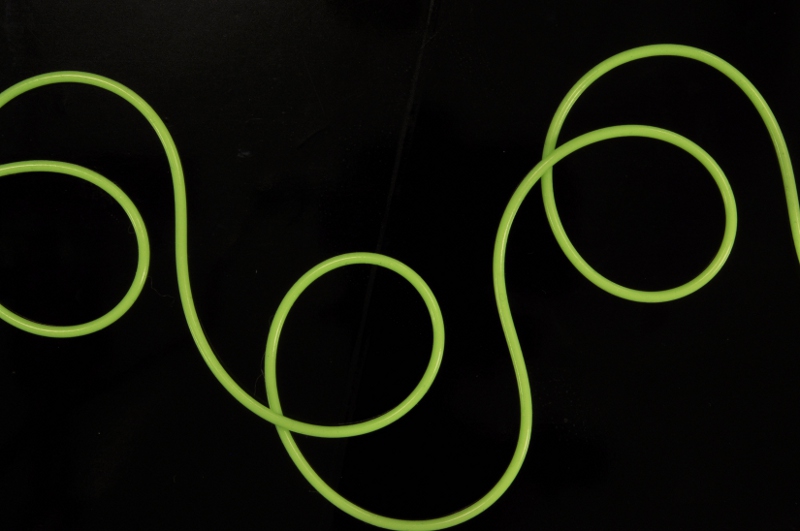
As a master intern, I participated in the Coiling Spaghetti project under supervision of Pedro M. Reis at MIT, performing preliminary experiments on the role of natural curvature of a rod on coiling patterns obtained when this rod is deposited onto a moving substrate. By designing home-made rods with customizable natural curvature, we were able to vary this parameter over a large range to test its influence on the patterns, and compare precision desktop-scale experiments to numerical simulations.
This setup can model problems that range from the macroscopic length scale (e.g. the deposition of transoceanic cables) to the microscopic length scale (e.g. coiling of carbon nanotubes). The common ingredient in all these cases is the prominent role of large deformations of a thin elastic rod impacting a rigid boundary.
(with Pedro Reis' research group, MIT)
II- SHORT CV
Work experience
2019-... Permanent researcher (chargée de Recherche CNRS, first in section 5, and then in section 8 starting on 2025) at Institut Charles Sadron, Strasbourg, France.
2017-2019 Postdoctoral researcher at Norwestern University, Evanston, USA, under supervision of Pr. John Rogers.
2013-2017 Agrégée préparatrice (PhD thesis + 192h/year teaching) at Ecole Normale Supérieure de Paris (teaching) and Institut Jean Le Rond d Alembert, UPMC, Paris (research)
Awards
2024 Prix Guy Ourisson du Cercle Gutenberg
2024 Prix Jeune Chercheur FRMNGE (Fédération Matériaux et Nanosciences Grand Est)
2023 Prix Espoir de l'Université de Strasbourg
2022 Gallery of Soft Matter Award - American Physical Society
2022 Finaliste du concours photo Mécapixel - CNRS INSIS
2018 PhD Prize from the Chancellerie des Universités de Paris - Prix Gandy 2018
2018 Saint-Gobain Young Researcher Prize - Société Française de Physique
Education
2013-2017
PhD thesis, UPMC, Paris, under supervision of Pr. Sébastien Neukirch
and Pr. Arnaud Antkowiak. "Soft Interfaces: from elastocapillary
snap-through to droplet dynamics on elastomers"
2009-2013 Studies at the Ecole Normale Supérieure de Paris, including:
2013: Agrégation in Physics
2012: Masters degree in Fundamental Physics, specialized in Soft Matter Phyics, UPMC, Paris
2011: 6-month Research internship at MIT, under supervision of Pr. Pedro Reis
2010: Bachelors degree in Fundamental Physics, Ecole Normale Supérieure de Paris
2007-2009 Classes préparatoires PCSI-PC* (two-year program in Physics, Chemistry and Mathematics)
Engagement in the scientific community
2024-.. Member of lab council of ICS
2021-.. Member of the scientific committee of GDR MePhy
2020-2023 Elected member of the executive board of the French Physical Society (Société Française de Physique)
III - MOST RECENT PUBLICATIONS
full updated list on my google scholar profile, accessible here
2025
Journal articles
- titre
- Crystalline structures in foams: guided mechanical self-assembly of bubbles in fiber arrays
- auteur
- Marwan Chammouma, Manon Jouanlanne, Antoine Egelé, Damien Favier, Jean Farago, Aurélie Hourlier-Fargette
- article
- Journal of Physics: Materials, 2025, 8 (1), pp.015011. ⟨10.1088/2515-7639/adaa21⟩
- Resume_court
- Spontaneous mechanical self-assembly of monodisperse bubbles generally leads to disordered foams at .....
- typdoc
- Journal articles
- DOI
- DOI : 10.1088/2515-7639/adaa21
- Accès au texte intégral et bibtex
-


2024
Journal articles
- titre
- Elastic ribbons in bubble columns: when elasticity, capillarity and gravity govern equilibrium configurations
- auteur
- Jean Farago, Manon Jouanlanne, Antoine Egele, Aurélie Hourlier-Fargette
- article
- Physical Review E , 2024, 110, pp.024803. ⟨10.1103/PhysRevE.110.024803⟩
- Resume_court
- Taking advantage of the competition between elasticity and capillarity has proven to be an efficient .....
- typdoc
- Journal articles
- DOI
- DOI : 10.1103/PhysRevE.110.024803
- Accès au texte intégral et bibtex
-


- titre
- Bubbling up in a Lab-on-a-Chip: A gravity-driven approach to the formation of polyelectrolyte multilayer capsules and foams
- auteur
- Stéphane Pivard, Aurélie Hourlier-Fargette, Guillaume Cotte-Carluer, Duzhi Chen, Antoine Egele, Christophe Lambour, Francois Schosseler, Wiebke Drenckhan-Andreatta
- article
- Colloids and Surfaces A: Physicochemical and Engineering Aspects, 2024, 700, pp.134608. ⟨10.1016/j.colsurfa.2024.134608⟩
- typdoc
- Journal articles
- DOI
- DOI : 10.1016/j.colsurfa.2024.134608
- Accès au texte intégral et bibtex
-


- titre
- Methodology for Liquid Foam Templating of Hydrogel Foams: A Rheological and Tomographic Characterization
- auteur
- Manon Jouanlanne, Imene Ben‐djemaa, Antoine Egelé, Leandro Jacomine, Jean Farago, Wiebke Drenckhan, Aurélie Hourlier‐fargette
- article
- Advanced Materials Interfaces, 2024, 11 (31), pp.2400337. ⟨10.1002/admi.202400337⟩
- Resume_court
- Hydrogel foams are widely used in many applications such as biomaterials, cosmetics, foods, or agric .....
- typdoc
- Journal articles
- DOI
- DOI : 10.1002/admi.202400337
- Accès au texte intégral et bibtex
-


- titre
- Solidification of Polyurethane Model Foams via Catalyst Drainage from a Secondary Foam
- auteur
- Manon Jouanlanne, Antoine Egelé, Wiebke Drenckhan, Jean Farago, Aurélie Hourlier‐fargette
- article
- Macromolecular Rapid Communications, In press, ⟨10.1002/marc.202400254⟩
- Resume_court
- Due to their unique mechanical and thermal properties, polyurethane foams are widely used in multipl .....
- typdoc
- Journal articles
- DOI
- DOI : 10.1002/marc.202400254
- Accès au texte intégral et bibtex
-


2023
Journal articles
- titre
- Soft Matter Roadmap
- auteur
- Jean-Louis Barrat, Emanuela del Gado, Stefan Egelhaaf, Xiaoming Mao, Marjolein Dijkstra, David Pine, Sanat Kumar, Kyle Bishop, Oleg Gang, Allie Obermeyer, Christine Papadakis, Costantinos Tsitsilianis, Ivan Smalyukh, Aurelie Hourlier-Fargette, Sebastien Andrieux, Wiebke Drenckhan, Norman Wagner, Ryan Murphy, Eric Weeks, Roberto Cerbino, Yilong Han, Luca Cipelletti, Laurence Ramos, Wilson Poon, James Richards, Itai Cohen, Eric Furst, Alshakim Nelson, Stephen Craig, Rajesh Ganapathy, Ajay Kumar Sood, Francesco Sciortino, Muhittin Mungan, Srikanth Sastry, Colin Scheibner, Michel Fruchart, Vincenzo Vitelli, S. Ridout, M. Stern, I. Tah, G. Zhang, Andrea Liu, Chinedum Osuji, Yuan Xu, Heather Shewan, Jason Stokes, Matthias Merkel, Pierre Ronceray, Jean-François Rupprecht, Olga Matsarskaia, Frank Schreiber, Felix Roosen-Runge, Marie-Eve Aubin-Tam, Gijsje Koenderink, Rosa Espinosa-Marzal, Joaquin Yus, Jiheon Kwon
- article
- Journal of Physics: Materials, 2023, ⟨10.1088/2515-7639/ad06cc⟩
- Resume_court
- Soft materials are usually defined as materials made of mesoscopic entities, often self-organized, s .....
- typdoc
- Journal articles
- DOI
- DOI : 10.1088/2515-7639/ad06cc
- Accès au texte intégral et bibtex
-


2022
Journal articles
- titre
- Investigating Pore‐Opening of Hydrogel Foams at the Scale of Freestanding Thin Films
- auteur
- Sébastien Andrieux, Mayur Patil, Leandro Jacomine, Aurélie Hourlier‐fargette, Sascha Heitkam, Wiebke Drenckhan-Andreatta
- article
- Macromolecular Rapid Communications, 2022, 43 (17), pp.2200189. ⟨10.1002/marc.202200189⟩
- Resume_court
- Controlling the pore connectivity of polymer foams is key for most of their applications, ranging fr .....
- typdoc
- Journal articles
- DOI
- DOI : 10.1002/marc.202200189
- Accès au texte intégral et bibtex
-


- titre
- Elastocapillary deformation of thin elastic ribbons in 2D foam columns
- auteur
- Manon Jouanlanne, Antoine Egelé, Damien Favier, Wiebke Drenckhan, Jean Farago, Aurélie Hourlier-Fargette
- article
- Soft Matter, 2022, 18 (12), pp.2325-2331. ⟨10.1039/D1SM01687C⟩
- Resume_court
- The ability of liquid interfaces to shape slender elastic structures provides powerful strategies to .....
- typdoc
- Journal articles
- DOI
- DOI : 10.1039/D1SM01687C
- Accès au texte intégral et bibtex
-


2021
Journal articles
- titre
- Wireless, Skin‐Interfaced Devices for Pediatric Critical Care: Application to Continuous, Noninvasive Blood Pressure Monitoring
- auteur
- Claire Liu, Jin-Tae Kim, Sung Soo Kwak, Aurélie Hourlier-Fargette, Raudel Avila, Jamie Vogl, Andreas Tzavelis, Ha Uk Chung, Jong Yoon Lee, Dong Hyun Kim, Dennis Ryu, Kelsey B Fields, Joana L Ciatti, Shupeng Li, Masahiro Irie, Allison Bradley, Avani Shukla, Jairo Chavez, Emma C Dunne, Seung Sik Kim, Jungwoo Kim, Jun Bin Park, Han Heul Jo, Joohee Kim, Michael C Johnson, Jean Won Kwak, Surabhi R Madhvapathy, Shuai Xu, Casey M Rand, Lauren E Marsillio, Sue J Hong, Yonggang Huang, Debra E Weese-Mayer, John A Rogers
- article
- Advanced Healthcare Materials, 2021, 10 (17), pp.2100383. ⟨10.1002/adhm.202100383⟩
- Resume_court
- Indwelling arterial lines, the clinical gold standard for continuous blood pressure (BP) monitoring .....
- typdoc
- Journal articles
- DOI
- DOI : 10.1002/adhm.202100383
- Accès au texte intégral et bibtex
-


- titre
- Soft, skin-interfaced sweat stickers for cystic fibrosis diagnosis and management
- auteur
- Tyler R Ray, Maja Ivanovic, Paul M Curtis, Daniel Franklin, Kerem Guventurk, William J Jeang, Joseph Chafetz, Hannah Gaertner, Grace Young, Steve Rebollo, Jeffrey B Model, Stephen P Lee, John Ciraldo, Jonathan T Reeder, Aurélie Hourlier-Fargette, Amay J Bandodkar, Jungil Choi, Alexander J Aranyosi, Roozbeh Ghaffari, Susanna A Mccolley, Shannon Haymond, John A Rogers
- article
- Science Translational Medicine, 2021, 13 (587), ⟨10.1126/scitranslmed.abd8109⟩
- Resume_court
- The concentration of chloride in sweat remains the most robust biomarker for confirmatory diagnosis .....
- typdoc
- Journal articles
- DOI
- DOI : 10.1126/scitranslmed.abd8109
- Accès au texte intégral et bibtex
-


2020
Journal articles
- titre
- Soft, skin-interfaced microfluidic systems with integrated immunoassays, fluorometric sensors and impedance measurement capabilities
- auteur
- Sungbong Kim, Boram Lee, Jonathan T Reeder, Seon Hee Seo, Sung-Uk Lee, Aurélie Hourlier-Fargette, Joonchul Shin, Yurina Sekine, Hyoyoung Jeong, Yong Suk Oh, Alexander J Aranyosi, Stephen P Lee, Jeffrey B Model, Geumbee Lee, Min-Ho Seo, Sung Soo Kwak, Seongbin Jo, Gyungmin Park, Sunghyun Han, Inkyu Park, Hyo-Il Jung, Roozbeh Ghaffari, Jahyun Koo, Paul V Braun, John A Rogers
- article
- Proceedings of the National Academy of Sciences of the United States of America, 2020, 117 (45), pp.27906-27915. ⟨10.1073/pnas.2012700117⟩
- Resume_court
- Soft microfluidic systems that capture, store, and perform biomarker analysis of microliter volumes .....
- typdoc
- Journal articles
- DOI
- DOI : 10.1073/pnas.2012700117
- Accès au texte intégral et bibtex
-


- titre
- Skin-interfaced soft microfluidic systems with modular and reusable electronics for in situ capacitive sensing of sweat loss, rate and conductivity
- auteur
- Aurélie Hourlier-Fargette, Stéphanie Schon, Yeguang Xue, Raudel Avila, Weihua Li, Yiwei Gao, Claire Liu, Sung Bong Kim, Milan S Raj, Kelsey B Fields, Blake V Parsons, Kunhyuck Lee, Jong Yoon Lee, Ha Uk Chung, Stephen P Lee, Michael Johnson, Amay J Bandodkar, Philipp Gutruf, Jeffrey B Model, Alexander J Aranyosi, Jungil Choi, Tyler R Ray, Roozbeh Ghaffari, Yonggang Huang, John A Rogers
- article
- Lab on a Chip, 2020, 20 (23), pp.4391-4403. ⟨10.1039/D0LC00705F⟩
- Resume_court
- Stick-on electrodes capacitively coupled to single-use microfluidic channels enable contactless anal .....
- typdoc
- Journal articles
- DOI
- DOI : 10.1039/D0LC00705F
- Accès au texte intégral et bibtex
-


2022
Jouanlanne, M.; Egele, A.; Favier, D.; Drenckhan, W.; Farago, J.; Hourlier-Fargette, A. (2022), Elastocapillary deformation of thin elastic ribbons in 2D foam columns,Soft Matter,18(12) : 2325-2331 linkAndrieux, S.; Patil, M.; Jacomine, L.; Hourlier-Fargette, A.; Heitkam, S.; Drenckhan, W. (2022), Investigating Pore-Opening of Hydrogel Foams at the Scale of Freestanding Thin Films,Macromolecular Rapid Communications,43(17) : link
2021
Liu, C.; Kim, J.-T.; Kwak, S.S.; Hourlier-Fargette, A.; Avila, R.; Vogl, J.; Tzavelis, A.; Chung, H.U.; Lee, J.Y.; Kim, D.H.; Ryu, D.; Fields, K.B.; Ciatti, J.L.; Li, S.; Irie, M.; Bradley, A.; Shukla, A.; Chavez, J.; Dunne, E.C.; Kim, S.S.; Kim, J.; Park, J.B.; Jo, H.H.; Kim, J.; Johnson, M.C.; Kwak, J.W.; Madhvapathy, S.R.; Xu, S.; Rand, C.M.; Marsillio, L.E.; Hong, S.J.; Huang, Y.; Weese-Mayer, D.E.; Rogers, J.A. (2021), Wireless, Skin-Interfaced Devices for Pediatric Critical Care: Application to Continuous, Noninvasive Blood Pressure Monitoring,Advanced Healthcare Materials,10(17, Si) : linkRay, T.R.; Ivanovic, M.; Curtis, P.M.; Franklin, D.; Guventurk, K.; Jeang, W.J.; Chafetz, J.; Gaertner, H.; Young, G.; Rebollo, S.; Model, J.B.; Lee, S.P.; Ciraldo, J.; Reeder, J.T.; Hourlier-Fargette, A.; Bandodkar, A.J.; Choi, J.; Aranyosi, A.J.; Ghaffari, R.; McColley, S.A.; Haymond, S.; Rogers, J.A. (2021), Soft, skin-interfaced sweat stickers for cystic fibrosis diagnosis and management,Science Translational Medicine,13(587) : link
2020
Kim, S.; Lee, B.; Reeder, J.; Seo, S.H.; Lee, S.-U.; Hourlier-Fargette, A.; Shin, J.; Sekine, Y.; Jeong, H.; Oh, Y.S.; Aranyosi, A.J.; Lee, S.P.; Model, J.B.; Lee, G.; Seo, M.-H.; Kwak, S.S.; Jo, S.; Park, G.; Han, S.; Park, I.; Jung, H.-I.; Ghaffari, R.; Koo, J.; Braun, P.V.; Rogers, J.A. (2020), Soft, skin-interfaced microfluidic systems with integrated immunoassays, fluorometric sensors, and impedance measurement capabilities,Proceedings Of The National Academy Of Sciences Of The United States Of America,117(45) : 27906-27915 linkKim, S.B.; Koo, J.; Yoon, J.; Hourlier-Fargette, A.; Lee, B.; Chen, S.; Jo, S.; Choi, J.; Oh, Y.S.; Lee, G.; Won, S.M.; Aranyosi, A.J.; Lee, S.P.; Model, J.B.; Braun, P.V.; Ghaffari, R.; Park, C.; Rogers, J.A. (2020), Soft, skin-interfaced microfluidic systems with integrated enzymatic assays for measuring the concentration of ammonia and ethanol in sweat,Lab On A Chip,20(1) : 84-92 link
Hourlier-Fargette, A.; Schon, S.; Xue, Y.; Avila, R.; Li, W.; Gao, Y.; Liu, C.; Kim, S.B.; Raj, M.S.; Fields, K.B.; Parsons, V.B.; Lee, K.H.; Lee, J.Y.; Chung, H.U.; Lee, S.P.; Johnson, M.; Bandodkar, A.J.; Gutruf, P.; Model, J.B.; Aranyosi, A.J.; Choi, J.; Ray, T.R.; Ghaffari, R.; Huang, Y.; Rogers, J.A. (2020), Skin-interfaced soft microfluidic systems with modular and reusable electronics for in situ capacitive sensing of sweat loss, rate and conductivity,Lab On A Chip,20(23) : 4391-4403 link